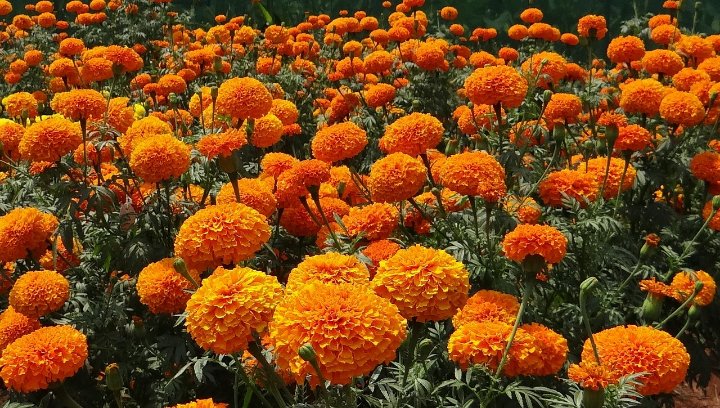In this blog post, we will cover everything you need to know about harvesting marigold seeds, from when to harvest to how to store them properly.
Understanding Marigold Seed Development
Before you begin harvesting, understand the life cycle of marigolds. After the flowering period, each flower head develops seeds, which can be collected once they are mature. It’s best to harvest seeds when the flowers start to dry out and turn brown, as this indicates that the seeds inside have fully matured.
When to Harvest Marigold Seeds
Timing is key when it comes to harvesting marigold seeds. Here’s how to know when it’s the right time:
Flower Condition: Wait until the marigold flowers have fully dried up and turned dark brown. This typically happens late in the growing season, often in late summer to early fall, depending on your location and the type of marigolds you are growing.
Seed Head Inspection: Gently squeeze the flower head. If it crumbles easily and sounds crunchy, that is a clear indication that the seeds are ready for harvesting.
Favorable Weather: Try to choose a dry day for harvesting. Moisture can lead to mold, ruining your seeds during storage.
How to Harvest Marigold Seeds
The process of collecting marigold seeds is simple. Here’s how you can do it:
Gather Your Tools: Get a pair of gardening gloves, scissors, paper bag or envelope, and a small bowl.
Cut the Flower Heads: Using scissors, carefully snip the dried flower heads off the plants, leaving a bit of the stem attached for easier handling.
Remove the Seeds: Place the dried flower heads in a bowl. Gently press or crush the flower heads to extract the seeds from the center. You may find several small seeds in each flower head.
Separate the Seeds: Discard any remaining flower debris and chaff, leaving only the seeds.
Storing Marigold Seeds
Once you have harvested your marigold seeds, proper storage ensures they remain viable for the next planting season:
Drying: Before storing, ensure the seeds are completely dry. Spread them out on a paper towel or newspaper for a few days to allow any remaining moisture to evaporate.
Containers: Store your seeds in a cool, dry place. Use small envelopes, paper bags, or airtight containers to prevent moisture ingress.
Labeling: Make sure to label your containers with the date and type of marigold seeds. This will help you track your stock over the years.
Storage Location: Keep your seeds in a dark, dry place, such as a drawer or a cupboard, to protect them from light and humidity.
Tips for Growing Marigolds from Seeds
Now that you have harvested and stored your marigold seeds, here are some tips for starting your marigolds next season:
Sow Indoors: Start seeds indoors about 6-8 weeks before the last frost date for your zone.
Transplant Carefully: When the seedlings have developed a couple of true leaves, transplant them to larger pots, or directly into the garden once all danger of frost has passed.
Watering: Keep the soil moist but not soggy. Marigolds prefer well-draining soil, so avoid overwatering.
Sunlight: Ensure your marigolds receive at least 6 hours of sunlight daily for optimal growth.
Why Grow Marigolds?
Before we jump into the seed-harvesting process, let’s briefly discuss why marigolds are a great addition to any garden:
Pest Control: Marigolds are known to repel nematodes and other pests, making them a natural ally for your vegetable and flower gardens.
Aesthetics: With their bright yellows, oranges, and reds, marigolds bring life to garden beds, borders, and containers.
Pollinator Friendly: Marigolds attract pollinators such as bees and butterflies, which can benefit the overall health of your garden.
Easy to Grow: These flowers thrive in most conditions, making them perfect for both beginner and experienced gardeners.
Additional Benefits of Growing Marigolds
In addition to being easy to grow and maintain, marigolds have a few other noteworthy benefits:
Companion Planting: Marigolds are often recommended for companion planting. They work well alongside vegetables such as tomatoes, peppers, and cucumbers by deterring harmful pests. Incorporating them into your planting scheme can lead to healthier and more productive crops.
Medicinal Uses: Some varieties of marigolds have been used in traditional medicine for their anti-inflammatory and antiseptic properties. It’s worth researching the different varieties if you’re interested in using them for herbal remedies.
Culinary Uses: The petals of some marigolds, particularly Calendula, are edible and can be used in salads, soups, or as a colorful garnish. Just make sure to confirm the specific variety is safe for consumption.
Common Varieties of Marigolds
If you are considering growing marigolds, it’s helpful to know about the various types available. Here are a few popular varieties:
French Marigolds (Tagetes patula): These compact flowers come in a variety of colors and have a strong scent that helps repel insects. They thrive in a variety of soils and are perfect for small garden spaces or borders.
African Marigolds (Tagetes erecta): These taller marigolds feature larger flowers and are often used for their striking appearance in the garden. They are known for their robust growth and are great for background plantings.
Signet Marigolds (Tagetes tenuifolia): These smaller marigolds have lacy foliage and produce edible flowers that can be used to enhance dishes. They have a milder scent and are often grown in herb gardens.
Troubleshooting Common Issues
While marigolds are generally hardy plants, you may encounter a few common issues. Here are some troubleshooting tips:
Pest Infestation: While marigolds help deter pests, they can still attract some, such as aphids. If you notice an infestation, use insecticidal soap or neem oil to control the problem.
Diseases: Issues like powdery mildew can arise in humid conditions. Ensure that your plants are well-spaced for air circulation and avoid overhead watering.
Stunted Growth: If your marigolds aren’t growing well, check the soil quality and make sure they’re getting adequate sunlight. Plants that are leggy may be reaching for light and may need to be spaced out more effectively.
Conclusion
Harvesting marigold seeds not only saves you money but also allows you to cultivate a sustainable and thriving garden. With their numerous benefits, ease of growth, and vibrant colors, marigolds are an excellent choice for both novice and experienced gardeners alike.
By following the steps outlined in this guide—understanding seed maturity, harvesting sincerely, storing wisely, and utilizing the seeds effectively—you’re setting yourself up for an abundant display of flowers in the next growing season.
So, gather your supplies, get your hands dirty, and enjoy the rewards of bringing these delightful flowers into your home and garden year after year. Happy planting!





